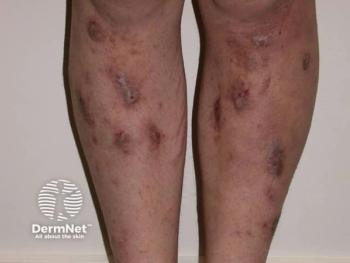
Advances continue in psoriasis treatment
New Orleans — There has been a boon in advances for the treatment of psoriasis, spanning an arsenal of new biologic therapies to new methods of administration of tried-and-true options.
New Orleans - There has been a boon in advances for the treatment of psoriasis, spanning an arsenal of new biologic therapies to new methods of administration of tried-and-true options.
The biologic evolution
Other recent research conducted by a variety of authors has shown that antibody responses to vaccinations are not affected by alefacept (Gottlieb, et al.), and dermatologists achieve a faster response to alefacept if they use it in combination with UVB (Koo J.)
Alefacept, in combination with methotrexate, is more effective than methotrexate alone for the treatment of psoriatic arthritis, according to Dr. Lebwohl. He cited a study by Dr. Alan Menter in which researchers compared treatment with alefacept plus methotrexate to placebo plus methotrexate. Fifty-four percent of patients in the combination group achieved American College of Rheumatology (ACR) 20, versus 23 percent in the control group.
"The news regarding efalizumab is that with longer term therapy, the benefit that was achieved early on is maintained, and a higher proportion of patients do seem to achieve PASI (Psoriasis Area and Severity Index) 75," he says.
The reports on thrombocytopenia from efalizumab are not clearly attributable to the treatment, but the Food and Drug Administration requires doctors who prescribe the drug to monitor platelet counts, according to Dr. Lebwohl.
"The other thing that has been a problem in the (efalizumab) clinical trials is rebound," Dr. Lebwohl says. "When you stop the drug, patients get a flare of their psoriasis. We have been able to manage that very well. We do not just stop the drug; we transition patients to other treatments."
Other news
In other news, etanercept is available in a pre-drawn syringe, no longer requiring that patients draw or reconstitute it, themselves. Patients administer the pre-drawn liquid at 50 mg, twice a week for three months.
"It turns out that most of that benefit is maintained even if you go to 50 mg once a week after that first three months," he tells Dermatology Times.
An important finding regarding etanercept is that it dramatically inhibits the damage from psoriatic arthritis. Other treatments, such as methotrexate, might help with pain but they do not prevent joint damage from psoriatic arthritis as effectively as etanercept.
Recent studies (by Mease et al and Ory) show that etanercept patients have less joint erosion after 12 months than at baseline, while joint erosion increased from baseline for patients on placebo. Joint space narrowing also seems to be dramatically reduced with etanercept versus placebo.
"This is important news, because probably 10 percent of psoriasis patients have significant psoriatic arthritis and are at risk of having a major deformity from it. And as many as 35 percent of psoriasis patients also have varying degrees of psoriatic arthritis," Dr. Lebwohl says.
Psoriatic arthritis
Adalimumab also appears to positively benefit psoriatic arthritis. A yet unpublished study (Mease P.) has clearly shown that, using the Psoriatic Arthritis Measurement, 62 percent of patients being treated with adalimumab experienced treatment success, versus 26 percent of placebo patients.
"Psoriasis severity scores benefited tremendously by adalimumab," Dr. Lebwohl says. "Injecting 40 mg every other week, 53 percent of patients achieved a PASI 75 in 12 weeks. If you look at 40 mg every week, 80 percent of patients achieved that PASI score."
Some dermatologists are also using infliximab as an off-label option in the treatment of psoriasis. Dr. Lebwohl considers using it for a variety of lesions, including hidradenitis, pyoderma gangrenosum, sarcoid and others.
Newsletter
Like what you’re reading? Subscribe to Dermatology Times for weekly updates on therapies, innovations, and real-world practice tips.


















